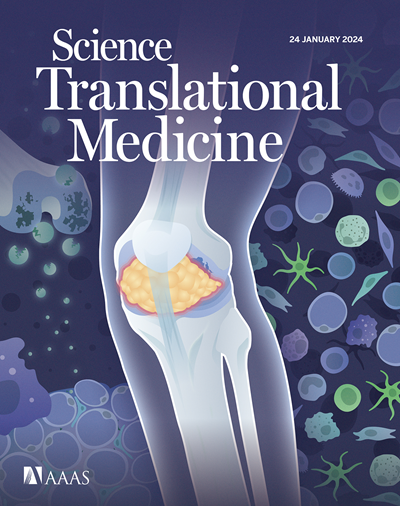RANKL治疗可恢复老年小鼠胸腺功能并改善T细胞介导的免疫反应
IF 15.8
1区 医学
Q1 CELL BIOLOGY
引用次数: 0
摘要
年龄相关性胸腺退化,导致T细胞生成减少,是免疫衰老的主要原因之一。这导致对癌症、感染和自身免疫的易感性增加,并降低了疫苗的效力。本研究发现胸腺核因子κB受体激活因子(RANK) -RANK配体(RANKL)轴在衰老过程中发生改变。使用条件转基因小鼠模型,我们证明内皮细胞依赖于RANK信号来实现其细胞结构和功能成熟。衰老过程中RANKL可用性的降低导致内皮细胞和胸腺上皮细胞的细胞结构和功能下降,从而导致胸腺退化。我们随后发现,在年轻小鼠中,RANKL中和可以模拟胸腺退化,而在老年小鼠中,外源性RANKL处理可以恢复胸腺结构以及内皮细胞和上皮细胞的丰度和功能特性。因此,RANKL改善了T细胞祖细胞归巢胸腺,促进了T细胞的产生。这一系列事件导致老龄小鼠外周血T细胞更新和有效的抗肿瘤和疫苗应答。此外,我们进行了一项概念验证研究,表明RANKL刺激人类胸腺器官培养中的内皮细胞和上皮细胞。总之,我们的研究结果表明,通过外源性RANKL给药靶向RANK-RANKL轴可能是一种恢复胸腺功能和改善衰老过程中T细胞免疫的治疗策略。本文章由计算机程序翻译,如有差异,请以英文原文为准。
RANKL treatment restores thymic function and improves T cell–mediated immune responses in aged mice
Age-related thymic involution, leading to reduced T cell production, is one of the major causes of immunosenescence. This results in an increased susceptibility to cancers, infections, and autoimmunity and in reduced vaccine efficacy. Here, we identified that the receptor activator of nuclear factor κB (RANK)–RANK ligand (RANKL) axis in the thymus is altered during aging. Using a conditional transgenic mouse model, we demonstrated that endothelial cells depend on RANK signaling for their cellularity and functional maturation. Decreased RANKL availability during aging resulted in a decline in cellularity and function of both endothelial cells and thymic epithelial cells, contributing to thymic involution. We then found that, whereas RANKL neutralization in young mice mimicked thymic involution, exogenous RANKL treatment in aged mice restored thymic architecture as well as endothelial cell and epithelial cell abundance and functional properties. Consequently, RANKL improved T cell progenitor homing to the thymus and boosted T cell production. This cascade of events resulted in peripheral T cell renewal and effective antitumor and vaccine responses in aged mice. Furthermore, we conducted a proof-of-concept study that showed that RANKL stimulates endothelial cells and epithelial cells in human thymic organocultures. Overall, our findings suggest that targeting the RANK-RANKL axis through exogenous RANKL administration could represent a therapeutic strategy to rejuvenate thymic function and improve T cell immunity during aging.
求助全文
通过发布文献求助,成功后即可免费获取论文全文。
去求助
来源期刊

Science Translational Medicine
CELL BIOLOGY-MEDICINE, RESEARCH & EXPERIMENTAL
CiteScore
26.70
自引率
1.20%
发文量
309
审稿时长
1.7 months
期刊介绍:
Science Translational Medicine is an online journal that focuses on publishing research at the intersection of science, engineering, and medicine. The goal of the journal is to promote human health by providing a platform for researchers from various disciplines to communicate their latest advancements in biomedical, translational, and clinical research.
The journal aims to address the slow translation of scientific knowledge into effective treatments and health measures. It publishes articles that fill the knowledge gaps between preclinical research and medical applications, with a focus on accelerating the translation of knowledge into new ways of preventing, diagnosing, and treating human diseases.
The scope of Science Translational Medicine includes various areas such as cardiovascular disease, immunology/vaccines, metabolism/diabetes/obesity, neuroscience/neurology/psychiatry, cancer, infectious diseases, policy, behavior, bioengineering, chemical genomics/drug discovery, imaging, applied physical sciences, medical nanotechnology, drug delivery, biomarkers, gene therapy/regenerative medicine, toxicology and pharmacokinetics, data mining, cell culture, animal and human studies, medical informatics, and other interdisciplinary approaches to medicine.
The target audience of the journal includes researchers and management in academia, government, and the biotechnology and pharmaceutical industries. It is also relevant to physician scientists, regulators, policy makers, investors, business developers, and funding agencies.
 求助内容:
求助内容: 应助结果提醒方式:
应助结果提醒方式:


